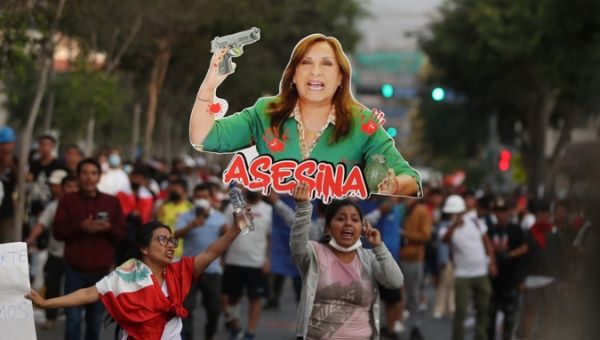By Amber Hamed, BA Politics and International Relations
On December 7th 2022, a parliamentary coup occurred in Peru ousting the democratically elected President Pedro Castillo through Congress, making Dina Boluarte President. This occurred as Article 113 of the Peruvian Constitution gives Peru’s Congress the authority to dissolve the presidency. If the right-wing oligarchy in Peru are able to bribe the majority of congress members to vote for presidential vacancy, they can overthrow the democratically elected President which is what happened to Pedro Castillo. This is reminiscent of Alberto Fujimori’s dictatorship, in which according to Peru Reports ‘a bribery scandal emerged involving Fujimori and Vladimiro Montesino over illegal wiretapping and embezzling government money to bribe politicians and public figures to support his 2000 re-election campaign’, as well as in 2018 when there was video evidence of his son, Kenji, bribing Congress to vote for presidential vacancy. This comes as Castillo sought to implement left-wing policies, and is the first Peruvian president of indigenous descent, majority of whom make up the working class population, meaning Castillo’s policies would not align with the economic and political interests of right-wing elites in Peru, who have long been accused of alleged collaboration with foreign governments.
“An overwhelming number of Peruvians (71%) are reproachful of the unelected President, Dina Boluarte.”
Boluarte’s presidency comes as she formed alliances with right-wing parties and was expelled from the leftist ‘Perú Libre’ party to which she later admitted that she “never embraced the ideology” of. Moreover, she was sworn in by the right-wing controlled Congress as she called for truce and unity with right-wing parties requesting “a political truce to install a government of national unity”. A statistic produced by the Institute of Peruvian Studies (IEP) shows an overwhelming number of Peruvians (71%) are reproachful of the unelected President, Dina Boluarte.
Since the beginning of Boluarte’s term as President, demonstrators, mostly emerging from working class rural areas and indigenous communities, have had 5 main demands. This includes her resignation, the closing of Congress, new elections, releasing Pedro Castillo after he was sentenced to 18 months in prison with no trial, as well as establishment of a Constituent Assembly to create a new Constitution and a plurinational state.
These protests have been met with violent repression by military and police forces controlled by Boluarte. For instance, on January 9, a massacre occurred in Juliaca, an indigenous Aymara town in which 17 peaceful protestors were killed by Peruvian police after participating in anti-Boluarte protests. Despite this repression, many demonstrators and organisations continue to mobilise as part of the national strike called the ‘Takeover of Lima’ in hopes that their demands are met. Thousands of Peruvians from all over the country continue to arrive in Lima, amongst them; workers, farmers and students in a call to unite against Boluarte’s US-backed, right-wing regime. The takeover of the city alongside the national strike, called by the workers’ unions, also comes as an outrage as since the protests began, there have been murders of over 50 Peruvians, mainly being of indigenous descent, by police and military.
Additionally, there is much speculation within and outside Peru of US involvement in the coup. This speculation arises as the US has a history of supporting regime change in Peru. It is essential to highlight Peru’s history in its struggle with US imperialism, interventionism and neo-liberal policies in order to understand current events. For instance, during Fujimori’s dictatorship, he sterilised more than 300,000 Peruvians, mainly of the poor and indigenous Peruvian community. This was supposedly funded by the US government through groups like USAID and UNFPA. The US’s alleged culpability in ethnic cleansing and genocide of the indigenous and working class population in Peru is prevalent to this day as it continues to directly involve itself in Peru’s affairs. For example, the US has been accused of involvement in the coup as Lisa Kenna, former CIA officer turned US ambassador to Peru, met with the coup regime’s minister of energy and mining on December 19th where they discussed themes ‘linked to the expansion of natural gas and mining investments’ as well meeting with Peru’s defence minister the day before the congressional coup on December 6th in which she shared tweets of reprimand against Castillo’s attempt to temporarily dissolve Congress. This is further evidenced by her meeting with Boluarte where she ‘reiterated her country’s full support for democratic institutions in Peru’.
Moreover, it is significant to again highlight article 113 of Peru’s Fujimori constitution which states that “The President of the Republic may vacate his office if his permanent physical or moral incapacity is declared by Congress.” This illustrates how Fujimori’s constitution and neo-liberal policies directly caused Peru’s constant political deadlock that led to Castillo’s attempt to dissolve Congress and ensured that democratic leadership could not be maintained.
And is the reason for Peruvians participating in the strike and taking to the streets demanding that congress be dissolved and for a new Constitution to be made.
With Peru being rich in copper, gold, silver, zinc, iron, lead and natural gas, it comes as no surprise that the US is interested in Peruvian affairs. Peru is the world’s second-largest producer of copper, silver, and zinc and Latin America’s largest producer of gold.
As working class and indigenous Peruvians continue to lead the struggle in resisting the unelected coup government and US hegemony over Latin America, their demands for sovereignty, control over their natural resources, dignity and justice intensify.
Photo Caption: Protestors participate in the “Takeover of Lima” march holding up a sign of Dina Boluarte titled “Murderer” in Lima, Peru on 19 January (Credit: EFE/Paolo Aguilar).
